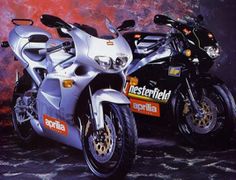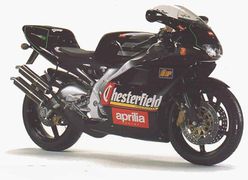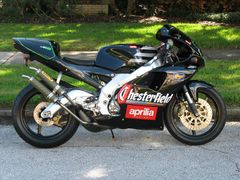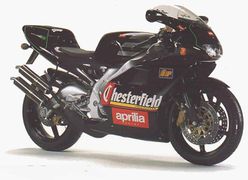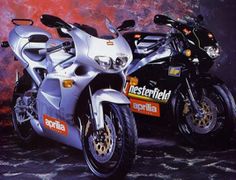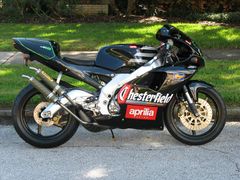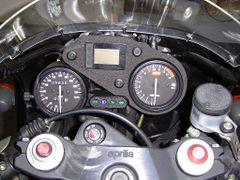Aprilia RS250 Chesterfield Replica
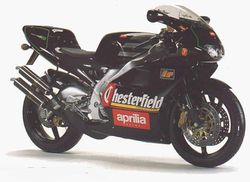 |
|
| Aprilia RS250 Chesterfield Replica | |
| Manufacturer | |
|---|---|
| Production | 1996 |
| Class | Sport Bike |
| Engine | Two stroke, 90° V twin-cylinder, with laminar suction and exhaust valve. Separate lubrication with variable automatic mixer |
| Compression ratio | 12.00 (+/- 0.7) : 1 |
| Top Speed | 209.5 km/h / 130.2 mph |
| Horsepower | 70.0 HP (52.2 KW) @ 11900RPM |
| Torque | 28.03 ft/lbs (38.0 Nm) @ 10750RPM |
| Ignition | CDI |
| Spark Plug | Standard - NGK BR9ECM racing - NGK BR10ECM cold climate - NGK BR8ECM |
| Battery | 12v 4Ah |
| Transmission | 6 Speed, direct drive |
| Suspension | Front: Ø40 mm Inverted fork with adjustable rebound and compression damping. Rear: Magnesium alloy swingarm. Monoshock with resevoir, adjustable extension, compression and spring preloading. |
| Brakes | Front: 2 x Ø298 mm discs, 4 piston calipers Rear: Single Ø220 mm disc, 2 piston caliper |
| Front Tire | 120/60-17 |
| Rear Tire | 150/60-17 |
| Wheelbase | 52.99 inches (1346 mm) |
| Length | 77.99 inches (1981 mm) |
| Width | 27.2 inches (691 mm) |
| Seat Height | 31.1 inches (790 mm) |
| Weight | 140 kg / 309 lbs (dry), 167 kg 368 lbs (wet) |
| Fuel Capacity | 16.5 L / 4.4 US gal |
| Manuals | Service Manual |
The Aprilia RS 250 Chesterfield Replica was a liquid-cooled, two-stroke, single cylinder Sport Bike motorcycle produced by Aprilia in 1996. Max torque was 28.03 ft/lbs (38.0 Nm) @ 10750 RPM. Claimed horsepower was 70.0 HP (52.2 KW) @ 11900 RPM. It could reach a top speed of 209.5 km/h / 130.2 mph.
Engine
The engine was a Liquid cooled cooled Two stroke, 90° V twin-cylinder, with laminar suction and exhaust valve. Separate lubrication with variable automatic mixer. The engine featured a 12.00 (+/- 0.7) : 1 compression ratio.
Drive
Power was moderated via the Oil bath, multiple-disc, with lever control on handlebars.
Chassis
It came with a 120/60-17 front tire and a 150/60-17 rear tire. Stopping was achieved via 2 x Ø298 mm discs, 4 piston calipers in the front and a Single Ø220 mm disc, 2 piston caliper in the rear. The front suspension was a Ø40 mm Inverted fork with adjustable rebound and compression damping. while the rear was equipped with a Magnesium alloy swingarm. Monoshock with resevoir, adjustable extension, compression and spring preloading.. The RS250 Chesterfield Replica was fitted with a 16.5 L / 4.4 US gal fuel tank. The bike weighed just 140 kg / 309 lbs. The wheelbase was 1370 mm / 53.9 in long.
1996 Aprilia RS 250 Chesterfield Replica
The 1996 MY Aprilia RS 250 Chesterfield Replica mainly addresses racing fans, boasting a graphic scheme that closely resembles the one found on House of Noale's offiacial Superbike Championship machines. In all other departments, it has the same features found on the base RS 250.
In the tech/engine department, it sports a liquid-cooled, two-stroke, 249cc, single cylinder powerhouse paired to a six-speed manual transmission, and can produce a claimed 70 horsepower and 38 Nm of torque.
Photos
Overview
You don't need to be Max Biaggi to get your socks blown off by the new RS250. But you do need to be to find much wrong with it. At the world launch of the stunning 250 at Misano the RS seemed to have it all: a fast motor; an exquisite chassis and, perhaps more than anything, the looks and detailing worth flogging granny for. All it lacked was the presence of the newly-crowned 250 world champion himself to give the bike his the Noale marque's lengthy experipersonal seal of approval. We've been waiting a long time from 50cc super shoppers to whizzo for Aprilia's 250 screamer. Despite 125s and world championship 250 trials and GP competition bikes, the eagerly-expected 250 road bike seemed to be the firm's Achilles heel. Over the last few years reports of 250 prototypes seizing or proving otherwise unreliable repeatedly found their way back to the UK. And for a variety of reasons Aprilia struggled to make a reliable V-twin stroker competitive with the class-leading RGV Suzuki. Ultimately, Aprilia gave up, instead surprisingly turning to Suzuki itself three years ago to forge a deal whereby the Japanese manufacturer now supplies a version of the proven RGV engine, redesigned to Aprilia's spec, to power the RS. However ironic, it's certainly an effective move. Although the engine remains essentially RGV, top end, exhaust, ignition, cooling and overall gearing changes make the engine in the RS both noticeably different in character and more potent on the road or track. And, gearing aside, the track (or maybe a glass display case) is where it belongs. Below 8000rpm you'd be better off on a bike with less than half the power: the RS kickstarts reluctantly, idles splutteringly and then burbles asthmatically until the revs approach five figures. That's the price you pay for the all-singing, all-dancing fireworks at the top of the range. But cog down or patiently wind the tacho needle over nine and the twin pipes crispen and the bike canters forward, faster and faster like a true racetrack refugee. It's all over, suddenly, at 12 thou then you notch up a gear for more: bouncing like a screaming maniac between ten and ll,50()rpm; keeping one eye on the tacho, your foot on the gear lever and your heart in your mouth. It's completely addictive, hooliganistically noisy and, Aprilia claims, a smidgen faster everywhere than the RGV. Its only problems on the track were gear ratios that are slightly too wide, especially in the lower gears, to always keep within the edges of that powerband. Although the gearbox itself is identical to the RGV's, a one tooth smaller rear sprocket raises overall gearing but also has the effect of spacing the ratios a touch wider. But on the road it's unlikely to make any odds. Where the RS really comes into its own is on the brakes and into corners. Here the RS makes all previous racer-rep stroker 250s seem five years out of date. And it does so with style. The Aprilia may carry a premium price tag but it's the no-expense-spared approach the firm has taken to the bike's chassis and cycle parts that will make the outlay worth it.
Aprilia's 'RGV'
DON'T BE FOOLED by the 'Aprilia Racing' on the cases. The RS engine is built
entirely by Suzuki and, bar a handful of crucial Aprilia design changes, is
mechanically identical to the RGV250. (Quite why Suzuki cooperated with Aprilia
to build a direct competitor to its RGV remains a mystery. Aprilia says Suzuki
didn't consider the RS a rival and RGV sales are now so low Suzuki says its
future is in different types of bike.)
Barrels, crank, clutch and gearbox are all identical to the RGV, however new
heads featuring reshaped combustion chambers (which hike compression to a
whopping 13.2:1 over the RGV's 7.3:1), enlarged coolant channels, all-new
expansion chambers and a reprogrammed ignition 'black box' make the RS engine a
markedly more potent beast.
Aprilia is claiming a peak of 69bhp for the RS - eight bhp over the RGV -plus
a power curve supposedly better throughout the entire range.
Gearbox and clutch are also stock RGV but the Aprilia wears a slightly
smaller rear sprocket which has the effect of raising overall gearing (even on
the test track's long straight the RS was still short of the redline in top but
showing 200kph, or 125mph, on the speedo) and exaggerating the spacing between
the ratios.
Fears about longevity should be quelled by the news that in Italy the bike is
being offered with a three year warranty. The UK is expected to follow suit. On
the launch, 15 bikes were caned mercilessly all day long without a single
seizure expect. The bars are quite flat and widely spaced and, though the pegs
are so high they're impossible to ground even on the track, the seat is such
that it's not too cramped. The RGV seems much more compact but in truth it s the
little Aprilia that is shorter, lighter and lower.
Once aboard you're instantly at home. The RS's light and low down weight
allied to steering that is slightly slower than the RGV make the machine
extremely predictable and easy to get on with. And it just gets better the
faster you go.
The brakes are absolutely astonishing, with the power to loft the rear wheel
with just two fingers and the sensitivity to confidently trail deep into
corners. But overall it's the balance between the super-rigid frame and
top-quality, multi-adjustable suspension that impresses most. Though a couple of
kilos lighter than the RGV, the sensuous pressed aluminum frame gives the RS a
solidity and integrity the RGV somehow lacks. The inverted Marzocchis up front
inspire complete confidence as does the rising rate rear shock once the
compression damping is wound right off (via a convenient knurled knob poking
from the side panel) even if the super-grippy Pirelli Dragon rear tire did cut
up alarmingly during the session. Put that lot together and you've got one of
the best-handling and least daunting road bikes ever built.
All of which would be fine for a special or the sort of bike destined only
for proddie racers but the telling class of the RS250 is not only what it does
but how well it's been put together. The styling speaks for itself. From
whatever angle you view it, the RS250 is mouth-wateringly beautiful. But when
you go through its component parts, one by one, it gets better yet: the
alluringly-sculpted front mudguard; the perfectly-blended headlight; the slim
and smooth (but useful) mirrors; that fantastic pressed and welded sheet
aluminum frame and 'banana' swing-arm; the neatly machined footrest hangers and
the lovely forged and polished aluminum heel protector plates. Not to mention
the svelte seat unit complete with closely-fitting pillion cover under which
lives the two-stroke filler and a useful sandwich compartment.
It's these things, the attention to detail, the flourishes of design and the
quality finish (a few peely stickers apart) that really ensures the RS250 will
blow the RGV into a cocked hat. Neat welding, polished aluminum and (admittedly
fake) carbon fibre abounds. Plus of course, there's the unique (and gimmicky)
LCD lap-timer which doubles as the temp gauge in the console. Phew, there's so
much to the RS, so much style, flair and potential pub boasting to it that, in a
way, how the bike goes is almost irrelevant.
But, having ridden it, the RS
turns out to be faster (just), handles better, is better braked and, for my
money, is much more fun than the RGV too. If any bike is going to come close to
the Ducati 916 for sheer desirability this year, the RS250 is surely it. And
against the 916s £11,000 price tag, the little Aprilia is an absolute steal.
Phil West
Source Bike 1995
| Make Model | Aprilia RS 250 Chesterfield Replica |
|---|---|
| Year | 1996 |
| Engine Type | Two stroke, 90° V twin-cylinder, with laminar suction and exhaust valve. Separate lubrication with variable automatic mixer |
| Displacement | 249 cc / 15.2 cu in |
| Bore X Stroke | 56 x 50.6 mm |
| Cooling System | Liquid cooled |
| Compression | 12.00 (+/- 0.7) : 1 |
| Lubrication | Oil pump with separate circuit |
| Induction | 2 x Ø34 mm Mikuni 34 SS flat side carburetors |
| Fuel Type | Lead-free petrol, R.O.N. minimum 95 |
| Engine Oil Recommendation | IP MAX 2T COMPETITION, or any high-quality oil meeting the ISO-L-ETC++ or API TC++ specifications |
| Air Filter | With polyurethane filter element |
| Ignition | CDI |
| Spark Plug | (tandard - NGK BR9ECM, racing - NGK BR10ECM, cold climate - NGK BR8ECM |
| Battery | 12v 4Ah |
| Starting | Kick |
| Max Power | 52.9 kW / 72.5 hp @ 11900 rpm |
| Max Power Rear Tire | 47.2 kW / 64.3 hp @ 10400 rpm |
| Max Torque | 40 Nm / 4.08 kgf-m / 29.5 lb/ft @ 10750 rpm |
| Clutch | Oil bath, multiple-disc, with lever control on handlebars |
| Transmission | 6 Speed, direct drive |
| Gear Box Oil Recommendation | IP FC, SAE 75W-90, or any high-quality oil meeting the API GL-4 specification |
| Final Drive | Chain, sealed, jointless, DID 520 V6 |
| Gear Change | With pedal (L), 1st low, other 5 high |
| Final Reduction | 14:42 (1:3.0) |
| Gear Ratio | 1st 11:27 (1:2.454) / 2nd 16:26 (1:1.625) / 3rd 17:21 (1:1.235) / 4th 22:23 (1:1.045) / 5th 24:22 (1:0.916) / 6th 25:21 (1:0.840) |
| Primary Reduction | 23:59 (1:2.565) |
| Front Suspension | Ø40 mm Inverted fork with adjustable rebound and compression damping. |
| Front Wheel Travel | 120 mm / 4.7 in |
| Rear Suspension | Magnesium alloy swingarm. Monoshock with resevoir, adjustable extension, compression and spring preloading. |
| Rear Wheel Travel | 130 mm / 5.1 in |
| Front Brakes | 2 x Ø298 mm discs, 4 piston calipers |
| Rear Brakes | Single Ø220 mm disc, 2 piston caliper |
| Front Wheel | 3.5 x 17 in. |
| Rear Wheel | 4.5 x 17 in. |
| Front Tire | 120/60-17 |
| Rear Tire | 150/60-17 |
| Rake | 25° |
| Turning Circle Ø | 4.09 m / 13.4 ft |
| Dimensions | Length: 1880 mm / 74.0 in Width: 690 mm / 27.2 in Height: 1080 mm / 42.5 in |
| Wheelbase | 1370 mm / 53.9 in |
| Seat Height | 810 mm / 31.9 in |
| Ground Clearance | 135 mm / 5.3 in |
| Dry Weight | 140 kg / 309 lbs |
| Wet Weight | 167 kg 368 lbs |
| Fuel Capacity | 16.5 L / 4.4 US gal |
| Reserve | 3.5 L / 0.9 US gal |
| Braking 60 Km/h / 37 Mph - 0 | 12.9 m / 42.3 ft |
| Braking 100 Km/h / 62 Mph - 0 | 36.8 m / 120.7 ft |
| Standing ¼ Mile | 12.50 sec / 172.5 km/h / 107.2 mph |
| Top Speed | 209.5 km/h / 130.2 mph |
| Road Test | Tuttomoto Test |
